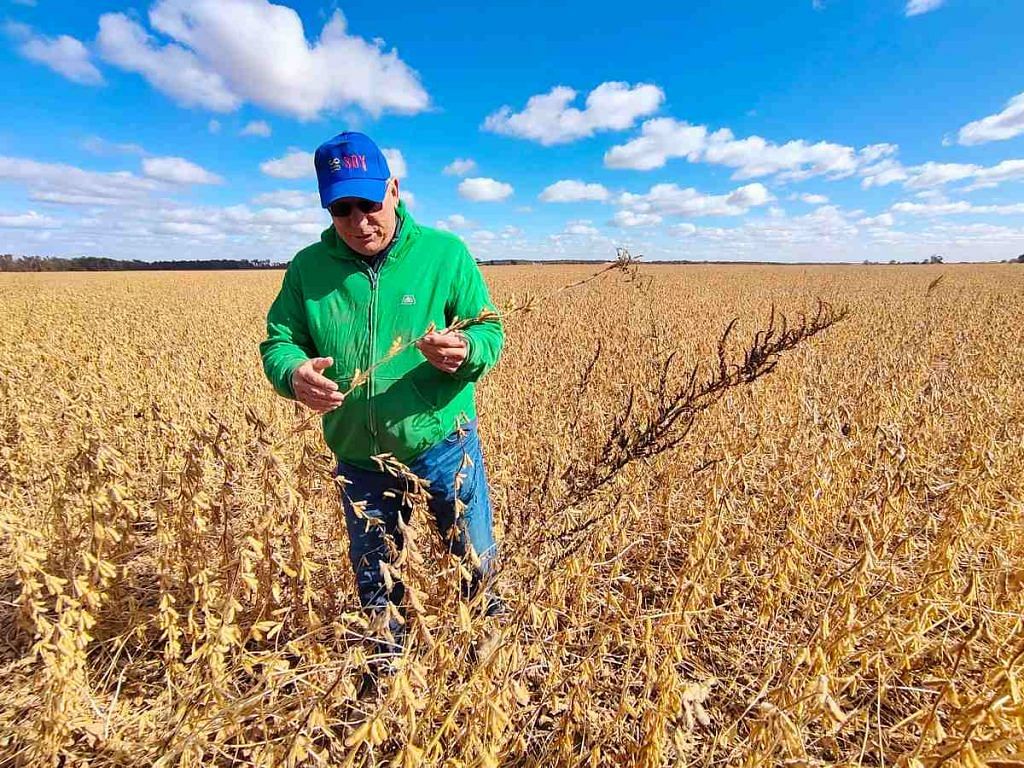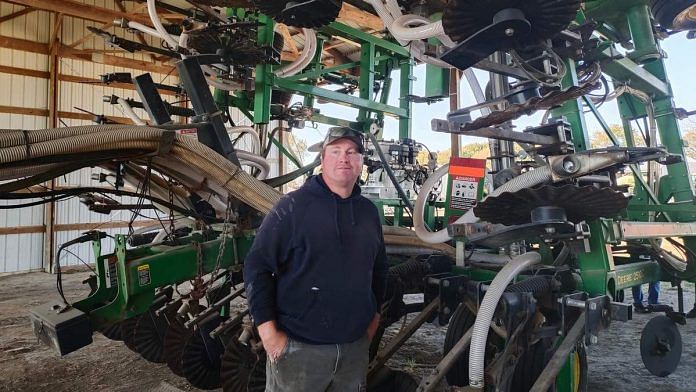Iowa, Illinois: Loads of hard work and despair when rains fail — these are about the only things that small soybean farmers in India have in common with their counterparts managing massive tracts of land in America’s Midwest, a land of corn and soy.
The rest, as a conversation with Corey Goodhue, a fourth-generation farmer from Iowa suggests, is vastly different.
Goodhue, for instance, harvested about 51 bushels per acre in October, which is about the same as the US average for the soybean harvest last year. That translates to productivity of 3.5 tonnes per hectare, about three-and-a-half times an Indian farmer’s average yield — 1.01 tonne per hectare.
It is not that Goodhue and other US farmers are not affected by the vagaries of nature and global socio-economic turbulence. But what contributes to their high yields is a combination of new technologies and sustainable practices.
A consequence of the abysmal yields in India is that the country imported about 70 per cent of the soybean oil it consumed in 2021-22 — 4.1 million tonnes of imports against the total domestic consumption of 5.8 million tonnes.
For the US, soybeans were the largest farm export item, accounting for more than $27 billion in export revenues in 2021.
Nearly all of the Indian imports were of oil derived from genetically modified (GM) and herbicide-tolerant soybeans from Argentina, Brazil, and the United States. India has also allowed imports of GM soybean meal to be used as cattle feed to meet the domestic shortfall.
Although India imports transgenic soy (and canola) oils, farmers in India are not allowed to grow these varieties. But this might change in the next few years.
Late last month, India’s biotech regulator recommended environmental release of GM mustard, a critical oilseed crop, marking an inflection point in the country for the entry of transgenics in food production.
Also read: Why is your tadka getting more & more expensive? Blame India’s reliance on edible oil imports
Bridging the yield gap
India is stuck with low yields and soaring imports because of its “broken policy on oilseed crops and edible oils”, said Bhagirath Choudhary, founder-director at the South Asia Biotechnology Centre.
“Oilseed crops such as mustard, soybean and sunflower are very important for dryland farmers and must be infused with globally available technologies and high-yielding germplasm (genetic materials, like seeds) to break the yield barrier, stagnant at around 1 tonne per hectare compared to 3-4 tonnes per hectare globally,” Choudhary said.
Access to better seeds, however, can only fix a part of the yield gap. American farmers are able to deploy expensive variable rate technology, cutting-edge machinery, and machine learning from on-farm data due to their scale of operations–giant farms of sizes between 3,000 acres and 15,000 acres.
In India, however, farmers operate on tiny patches of land, which limits capital investments and forces them to grow multiple crops in a year (instead of the single crop grown in the US Midwest).
This pressure, say, to plant wheat right after harvesting paddy, leads to burning of crop stubble, instead of letting the straw decompose and add to soil nutrition.
High-tech farming
What are the factors driving high yields in the US? According to Goodhue, it’s a combination of technologies, quality seeds, high-end machinery, and learnings from yield maps, coupled with sustainable practices such as using cover crops and zero-till farming (to retain soil carbon and moisture).
“We use technology and devices which map yields… and record where the bushels are coming from. For nutrient application and planting seeds, we use variable rate technology (VRT),” Goodhue said.
VRT is a technical tool where sensors map soil health in real time before nutrients such as nitrogen or phosphates are applied. It helps farmers save on expensive fertilisers and seeds, leading to higher production.
For Goodhue, who manages 3,800 acres of farmland in Iowa, these technologies help to deal with the vagaries of weather and market swings. But there are times, he says, when he feels like a professional gambler because of the factors beyond his control — drought, erratic rains, a trade war with China leading to a plunge in exports, or the Ukraine conflict driving up fertiliser prices.
What does he do when rains fail during planting? “We cry,” he said.
Nevertheless, advances in seed technology have helped counter the effects of erratic weather.
“If we had the same seed that they planted in the 1980s, the yields would have been next to nothing… We now have seeds which can handle cold and wet soils better than they ever could before,” Goodhue said. “We do see the companies push very, very hard to be the best they can, because they compete for our business.”
Sustainable soy
According to Doug Winter, a farmer from Illinois and the chairman of the U.S. Soybean Export Council (USSEC), the soy-corn rotation practiced in the Midwest helps to keep the soil healthy and limit fertiliser use.
“Soybeans pull nitrogen out of the air (and fixes it into the soil)… for every bushel yield you get per acre, you gain about half a pound of nitrogen that will stay in the soil for the corn crop next year,” he said, standing next to a ready-to-harvest soy field. “That’s the reason we use the corn-soy rotation.”
Winter, 67, is a champion of US-grown ‘sustainable’ soy. He takes pride in how many farmers use cover crops such as cereal rye, rapeseed, and wheat after harvesting corn and soy.
Cover crops help in carbon sequestration (capturing and storing atmospheric carbon dioxide), increase soil microbial activity, improve soil fertility, and aid moisture retention — in essence, returning nutrients to the soil after a harvest.

“Our carbon footprint score is lower because we use cover crops in addition to crop rotation,” Winter said. “We are always on the lookout for newer and better practices. Farming can be sustainable but you need to bring in research and diligence (in adopting new processes) to be able to stay that way, year after year.”
Industrial farming has often been criticised as being damaging to the environment. But Robert Paarlberg, adjunct professor of public policy at the Harvard Kennedy School, vigorously disagrees.
“Modern farming protects the environment not only by using less land compared to several decades ago; it also uses less water, less fossil energy, and fewer chemicals for every bushel produced,” Paarlberg wrote in his 2021 book, Resetting the Table: Straight Talk About the Food We Grow and Eat.
Citing evidence from the Environment Protection Agency, Paarlberg wrote that total fertiliser use on American farms peaked in 1981 and has remained essentially flat in the decades since, even as crop production grew 44 per cent.
Similarly, use of insecticides peaked in 1972 and has since fallen by more than 80 per cent.
“In the marketing year 2021-22, about 59 per cent of the US soybean exports were certified sustainable under the Soybean Sustainability Assurance Protocol,” said Abbey Rinne, director of sustainability at USSEC. “Between 1980-2020 land use per tonne of soy production has fallen by 48 per cent with crop yields close to doubling.”
An arduous task
Despite the vastly advanced agricultural practices in the US, farming remains a nerve-wracking and strenuous enterprise. That’s something the Indian farmer can relate to.
Since he graduated in 1977, Winter spent a “whole lot of years in dirt”, he said, but his children are not keen on following in his footsteps. He understands why.
“It is long hours and there is a lot of hard work and then there’s bad years and you kind of wonder why you are out here. Of course, everybody’s job has that sooner or later.”
This reporter visited the US Midwest in October as a guest of the U.S. Soybean Export Council.
(Edited by R.Geethalakshmi)
Also read: Govt approves environmental release of GM mustard, paves way for commercial cultivation



